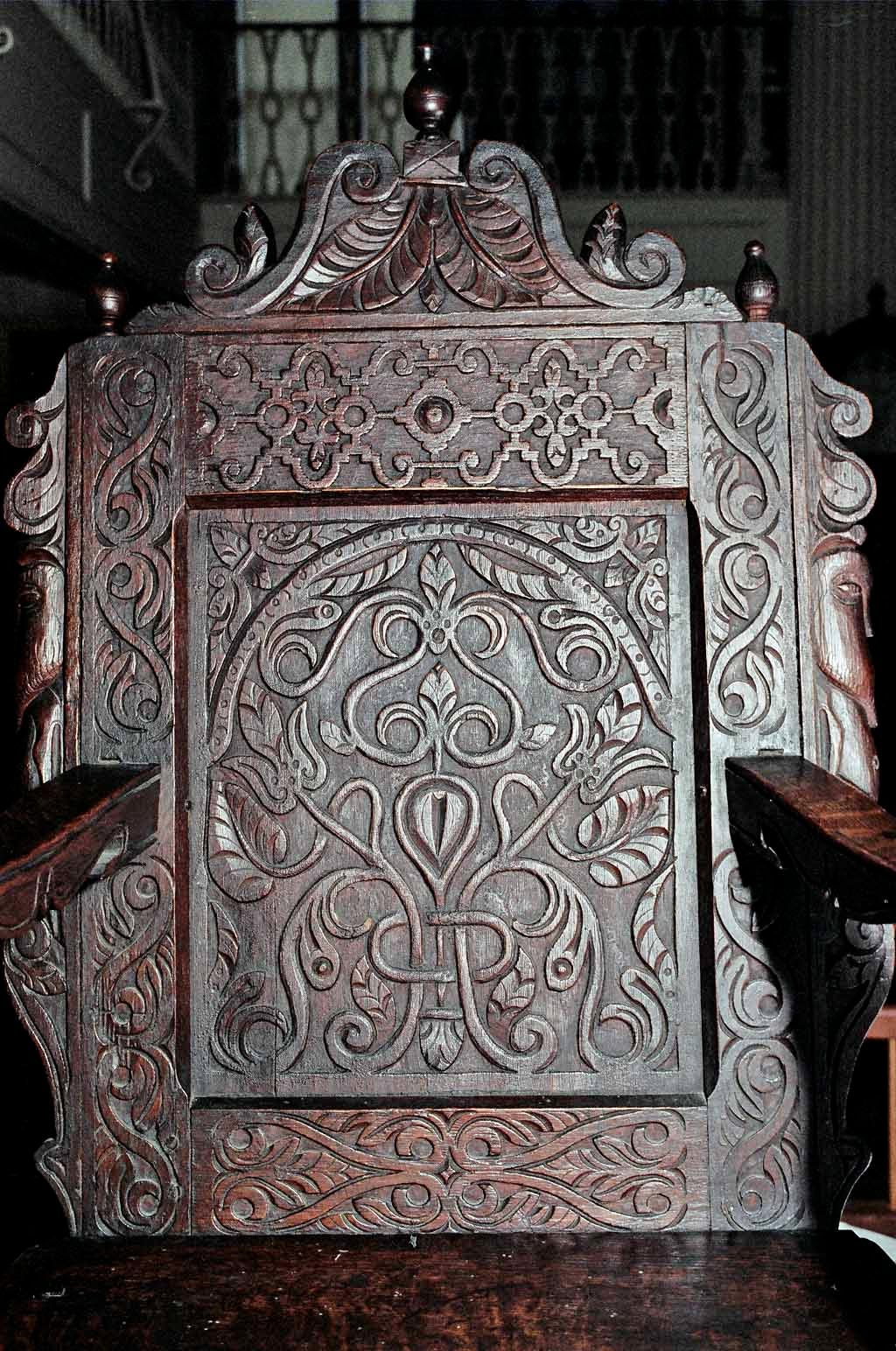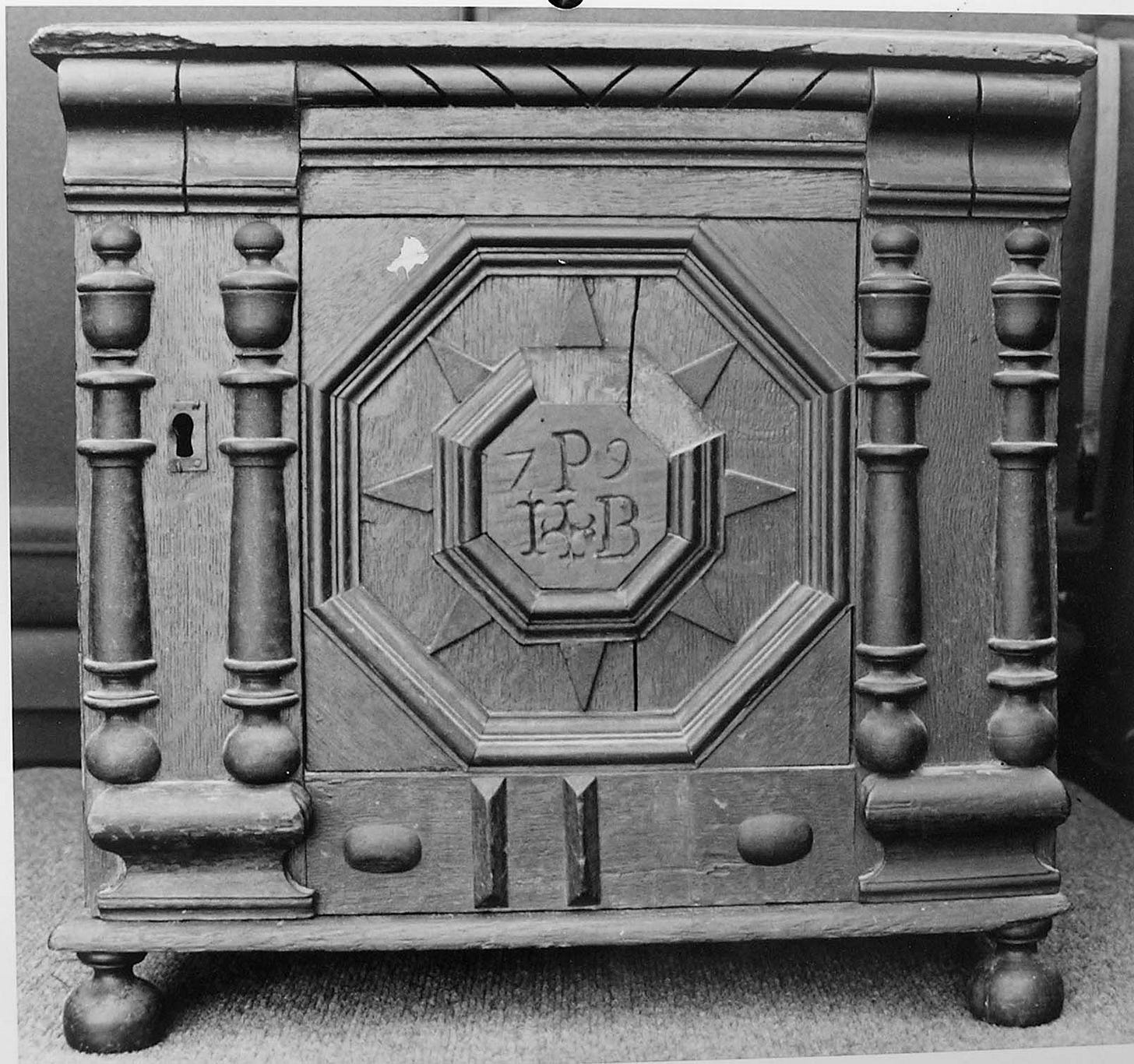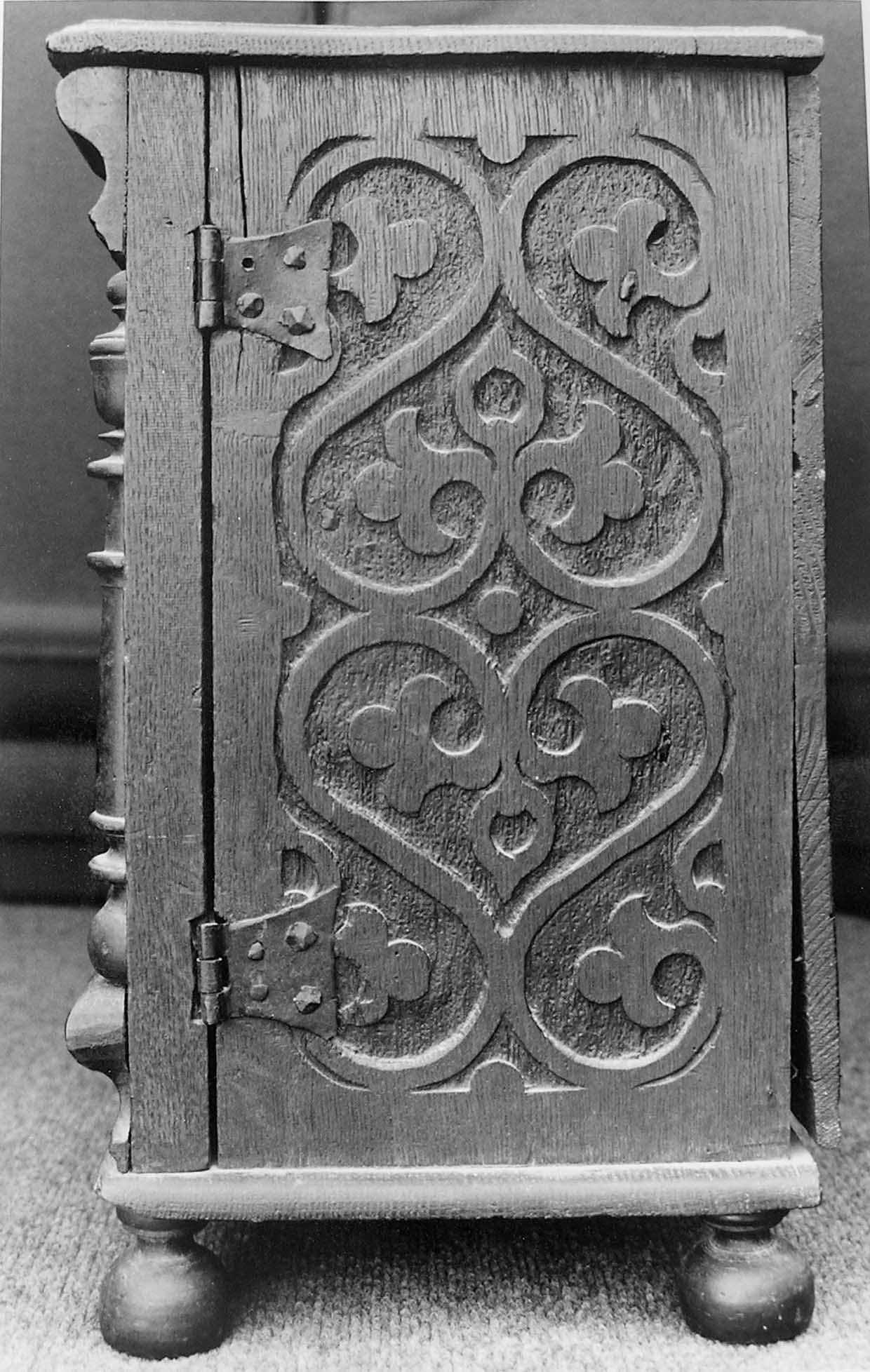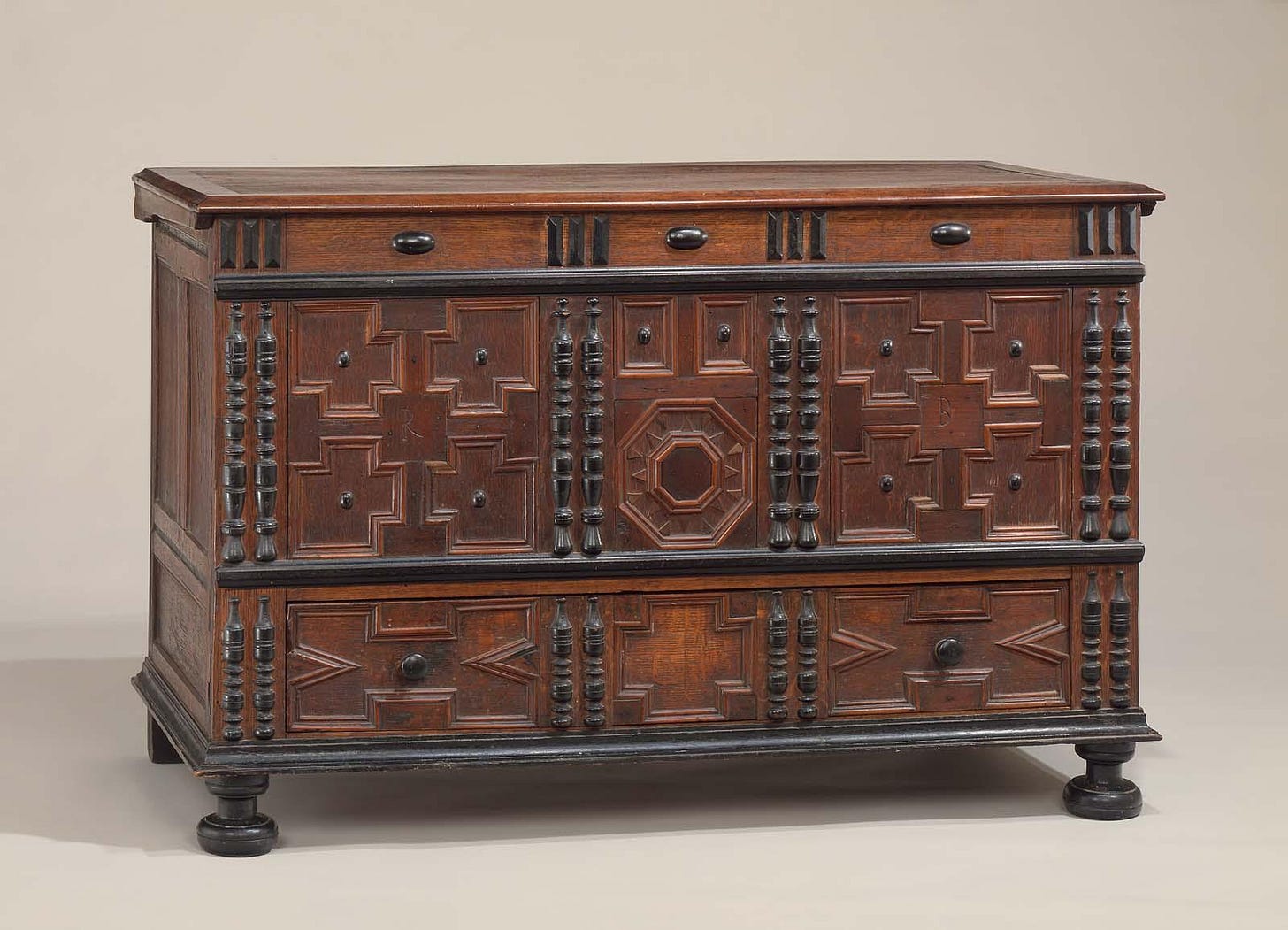Last time I wrote about the Yin Yu Tang house at the Peabody Essex Museum in Salem, Massachusetts. While I was at PEM I made sure to scoot through the galleries to see some old chestnuts that I know very well. They have a few excellent pieces of local 17th century joined works. One is a wainscot chair made in nearby Ipswich, by Thomas Dennis - donated to the Essex Institute in the 1820s - so now in captivity longer than it was a family piece.
Featuring a strapwork pattern across the top rail - and a great wide panel. This photo is from my friends Rob Tarule & Ted Curtin years ago.
PEM has a few other Thomas Dennis pieces but this is the only one on display right now. That I could find anyway. They do have several key pieces from Salem - including this little cabinet (a hideous photo I shot in the gallery)
Forget how horrible that photo is - I shot it because of a story about this cabinet. Peabody Essex bought it at auction in 2000 for a record-setting price for 17th-century American furniture, over 2 million dollars. The cabinet was made in Salem about 1679 for Joseph and Bathsheba Pope and descended in their family until the sale. Not long before that auction - I had the cabinet in my car:
[that’s a black-and-white print, with a tear on it. That white smudge outside the octagon is not on the cabinet]
Mark Atchison, my blacksmith friend and I were called on to make copies of it for the owners. I told the customer that we had to see the actual item, photos wouldn’t be enough. We needed to take our own details, measurements, notes, etc. So off I went with the owner and Ted Curtin who was shooting the photos. We got to the bank where the piece had been put for sake-keeping. The bank people just looked at us as if we were crazy and said they had no space we could use to do the examination. So we took the cabinet outside and did the whole thing in the back of my then-new 1999 Rav4.
From there I got on with making the parts and starting the process of making the cabinets. We ended up making a lot of them, maybe 8 or so. Mark couldn’t make it to that first examination, by the time he & I could get around to our next appointment the cabinet was now at Peabody Essex in its own alarmed display case. We made an appointment to come up and a very cooperative curatorial assistant (whose name I’ve unfortunately forgotten, this was over 20 years ago) made arrangements with the exhibit crew to dis-arm the case so we could take the cabinet out and see the insides, etc. They shut off the alarm, un-screwed the plexi cover and freed up the cabinet. Then the entire museum’s alarm went off and security came and told everyone to leave the building. Everyone. The woman helping Mark & I insisted she had to stay on account of the cupboard now being un-secured. Nope - everyone out. Was the timing co-incidental, or was this some hi-tech heist in action? Like the Thomas Crown affair…
She came out to the sidewalk, white as a sheet and in her hand were the screws from the plexiglass case. She was sure something awful was happening. I tried to convince her that the people from the Gardner museum eventually got new jobs…that joke sorta fell flat. Turns out it was mice or something in some wiring.
There’s lots of pieces from these Salem joiners - PEM has a cupboard from the same shop:
This cupboard has only three drawers in its lower case, resulting in deeper drawers than most from the period. Maybe more useful. This cupboard, the cabinet, some chests with drawers and chests of drawers are all attributed to John Symonds and his sons. PEM has a chest, but I couldn’t find it on display in a quick run through the galleries. Here’s one from the MFA instead:
Some excerpts from John Symonds’ 1671 will and probate inventory:
"...to my son James Symonds...I do assigne my servant John Pease to him dureing the term of time expressed in the Indenture... Further I give all my workinge tooles belonginge to my trade to my son James Symonds..."
From the inventory:
Joyners Tools benches and lare £5-5-6 2 Bedsteds almost finished £3 3 stools and one half of a Box 12s6d 1/2 Grindstone & windlass & a Small grindstone 5s Timber planke & board £5-12
...part of a Chest... 3 Chests 3 Boxes and a wooden Tunnil 14s 2 Tables a forum & Chayres 16s a Vice and an old Hatchet 10s nayles 10d an Ax 6s10d ...a p of Jemmils...5 wedges...one half of a Crosscut Saw... Timber in the Woods £1-2 an apprentice of 17 years old who hath 3 year and 9 moneths and 2 weekes to serve”
There’s a few articles about the Symonds shops, among them:
Robert Trent, “The Symonds Shops of Essex County, Massachusetts” in The American Craftsman and the European Tradition, 1620-1820, edited by Francis Puig and Michael Conforti, (Minneapolis, Minn.: Minneapolis Institute of Arts, 1989) pp. 23-41.
Martha Willoughby, “Patronage in Early Salem: The Symonds Shops and Their Customers” in American Furniture (2000) edited by Luke Beckerdite (Hanover, N.H.:
University Press of New England for the Chipstone Foundation, 2000) - this one is online at https://chipstone.org/article.php/458/American-Furniture-2000/Patronage-in-Early-Salem:-The-Symonds-Shops--and-Their-Customers
Robert F. Trent, “The Joseph and Bathsheba Pope Cabinet and the Symonds
Shops” in “The Joseph and Bathsheba Pope Valuables Cabinet,” Christie’s, New
York, Friday 21 January, 2000, pp. 18-21.
[Trent’s article there is part of a stand-alone catalog for the cabinet.]











Benno Forman first saw the MFA Boston Salem chest on the North Shore in 1967.
Hi Peter, the panel on that chair is astounding. Thanks again for all of your information.